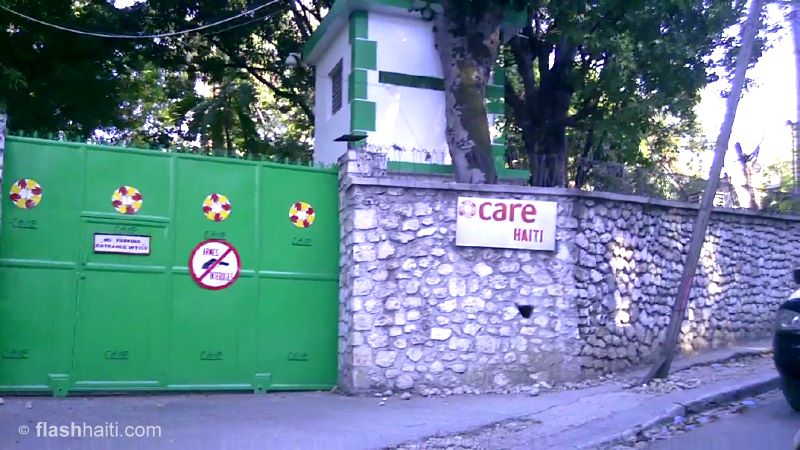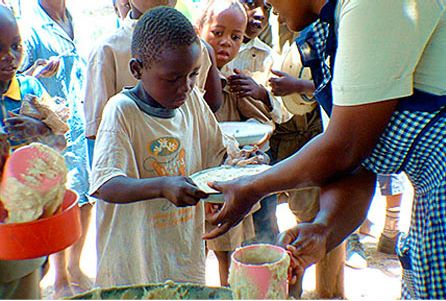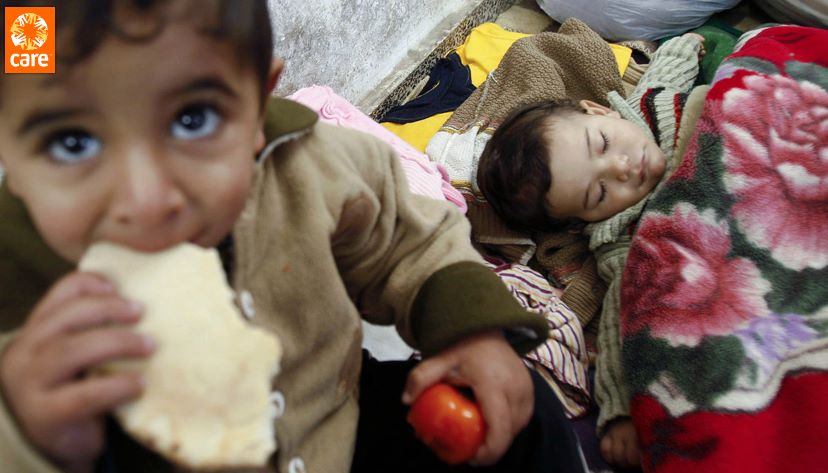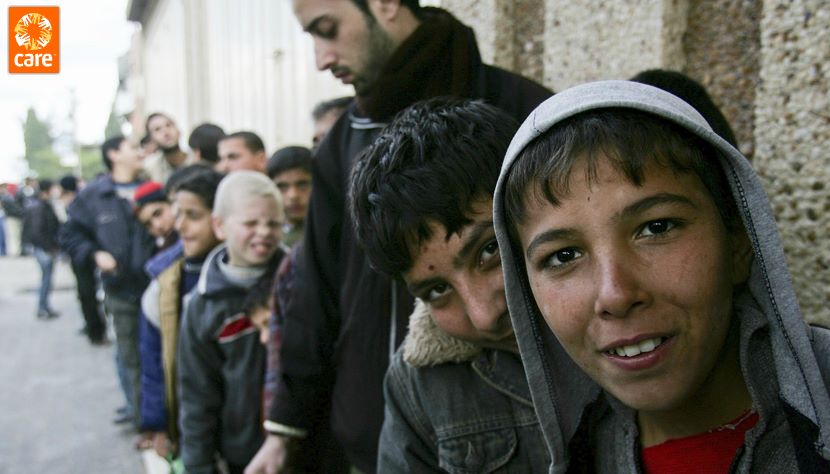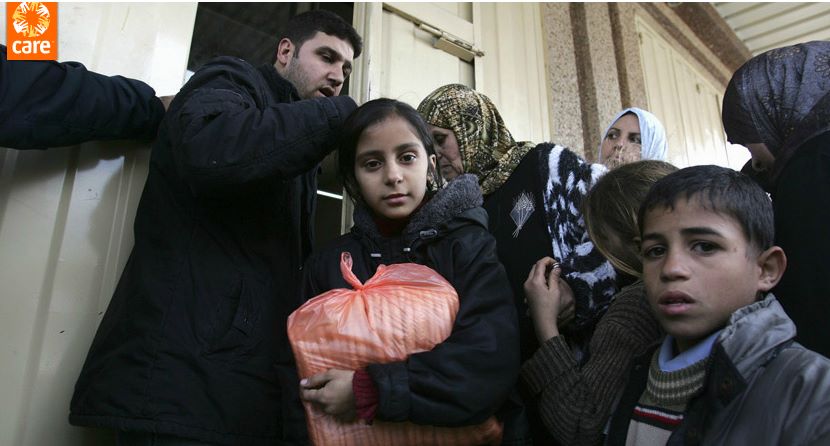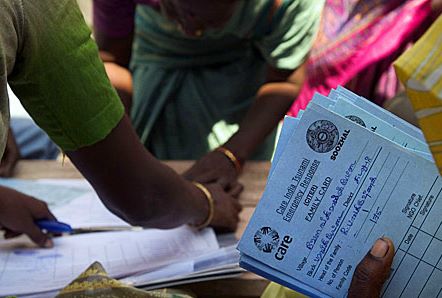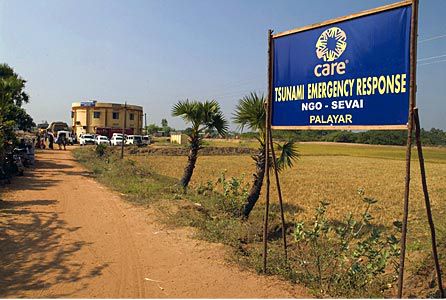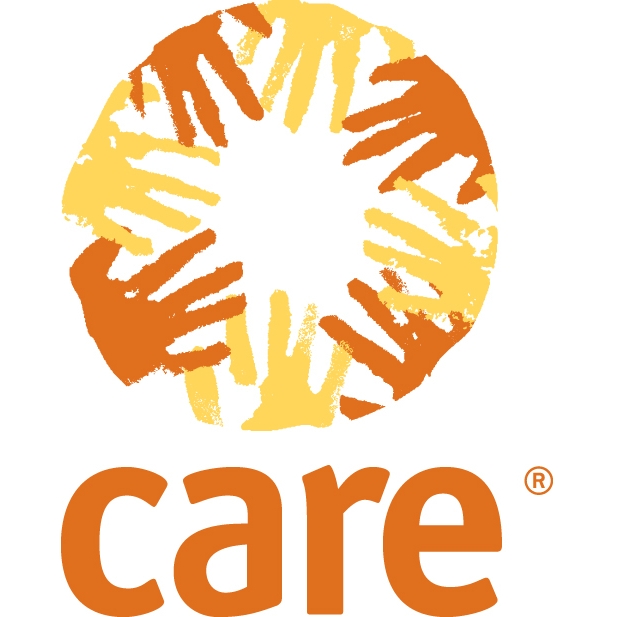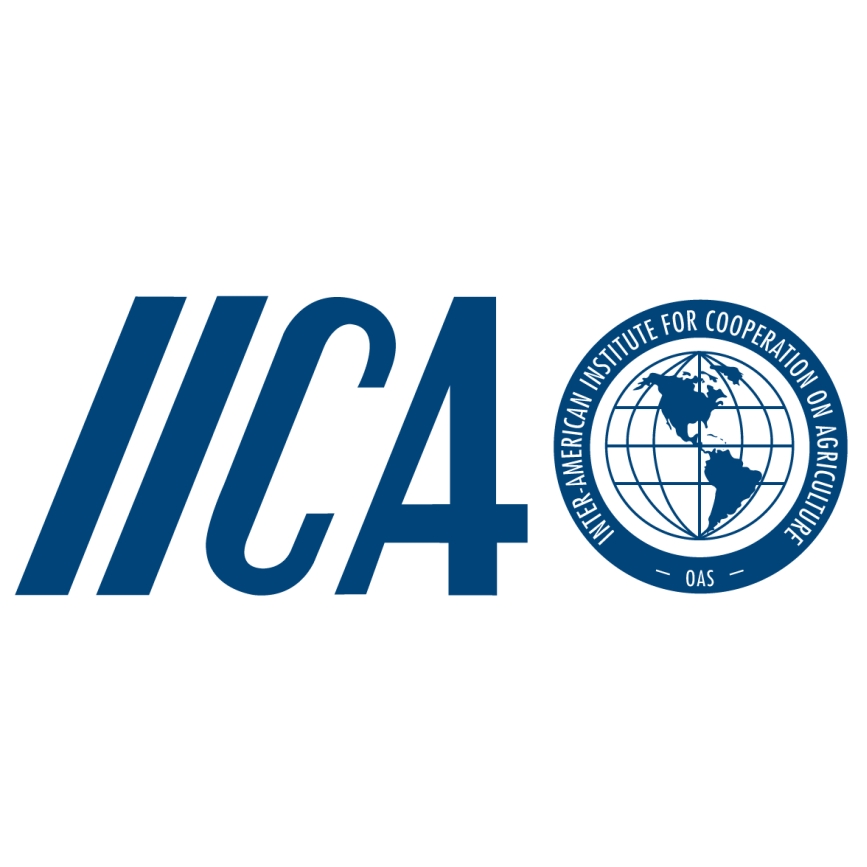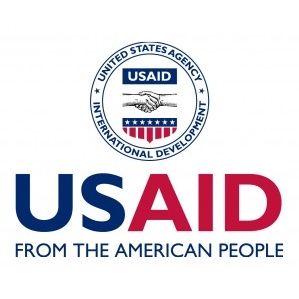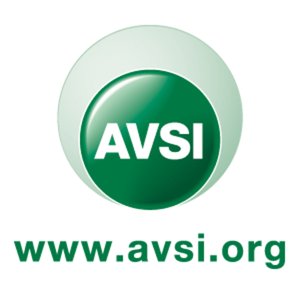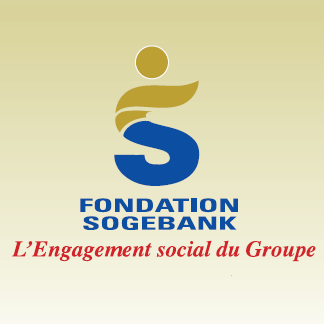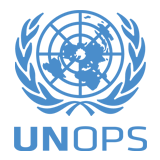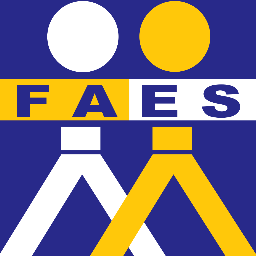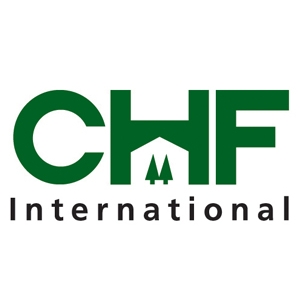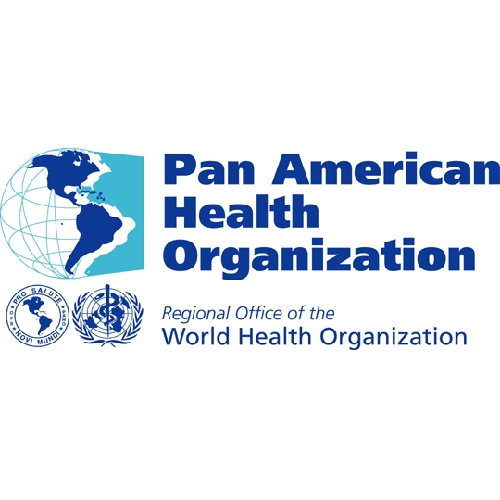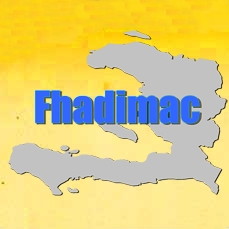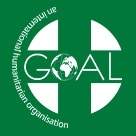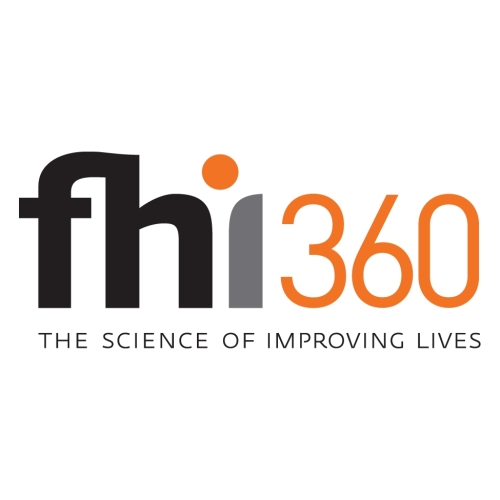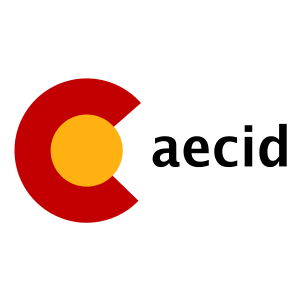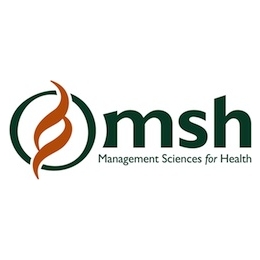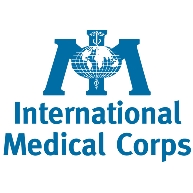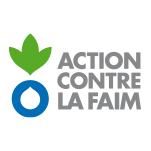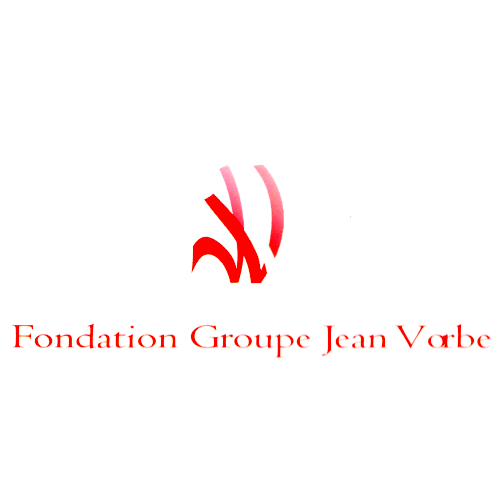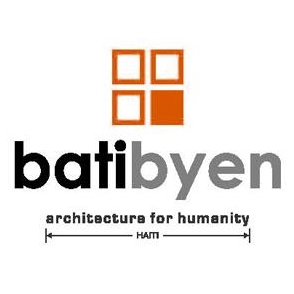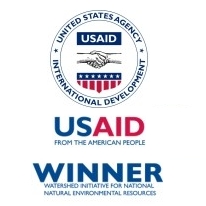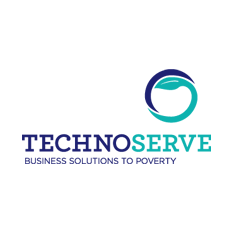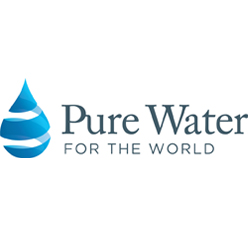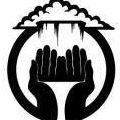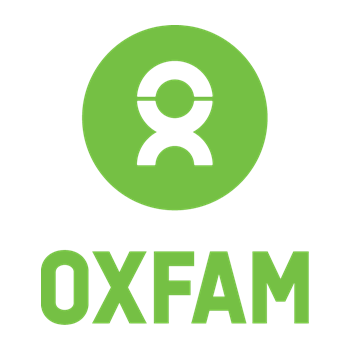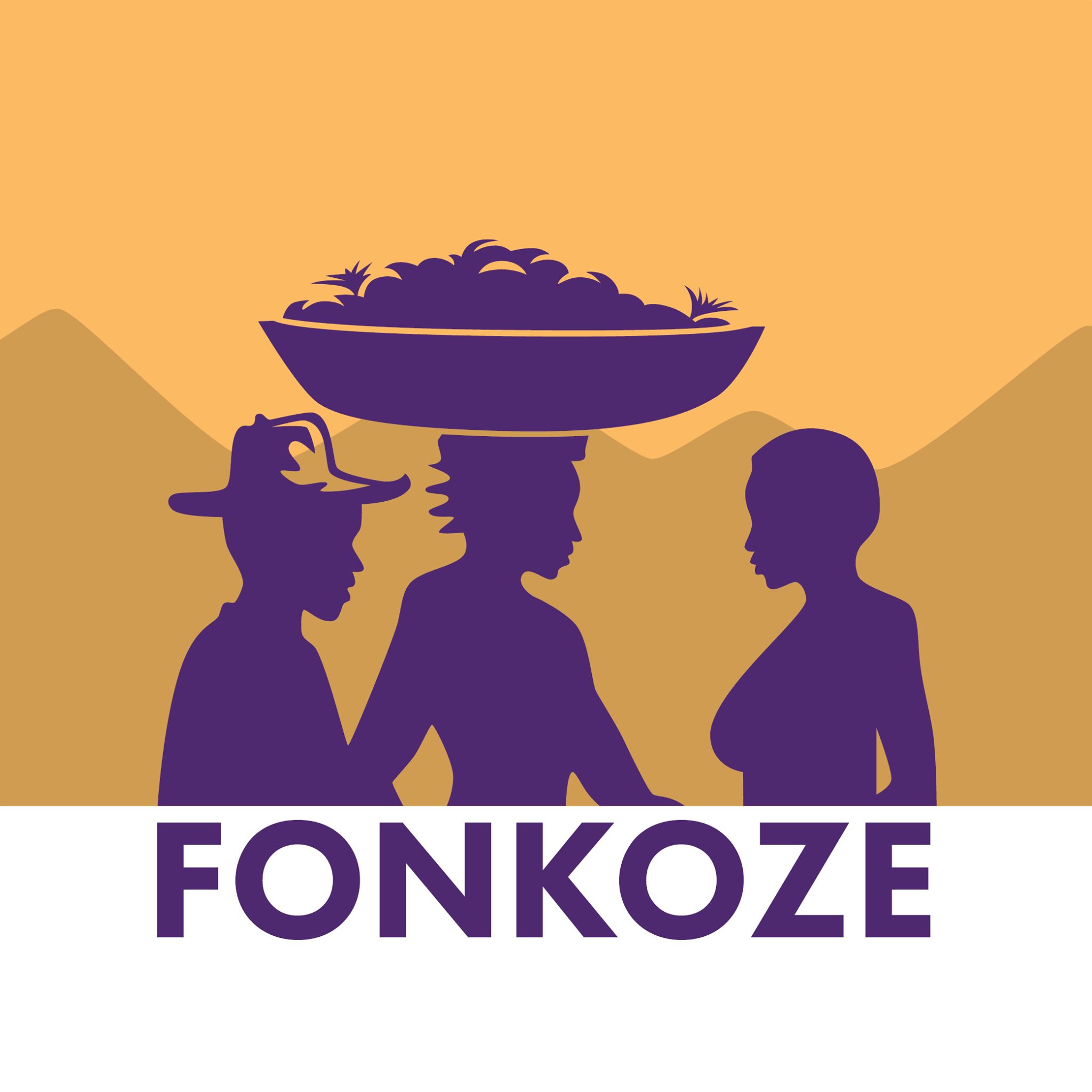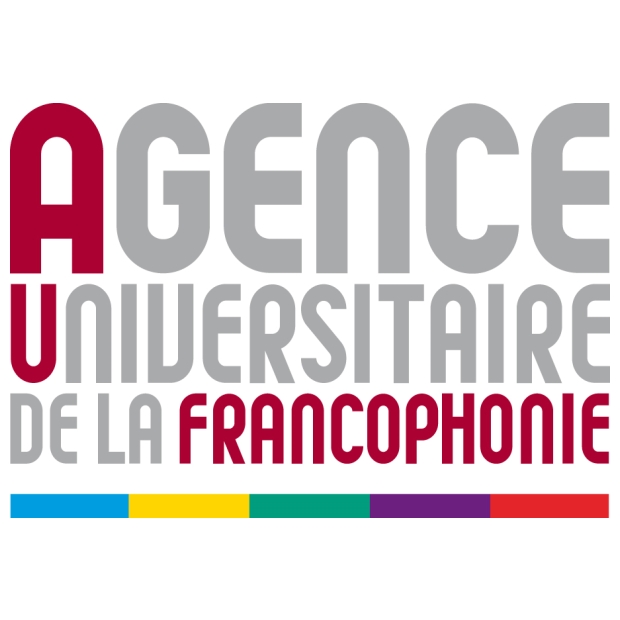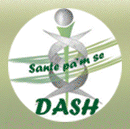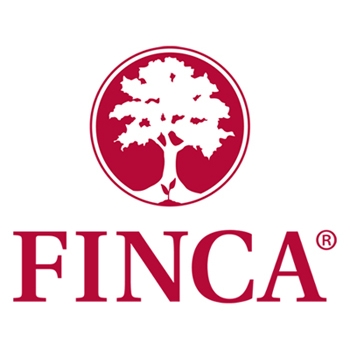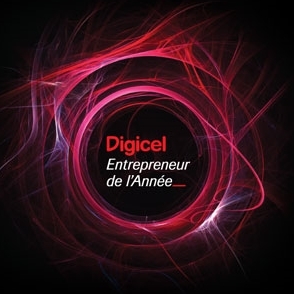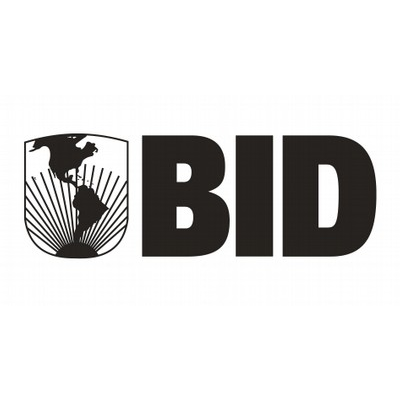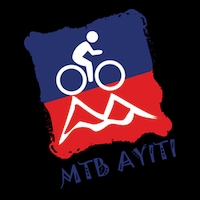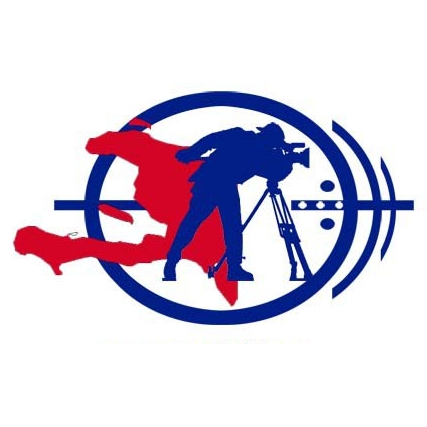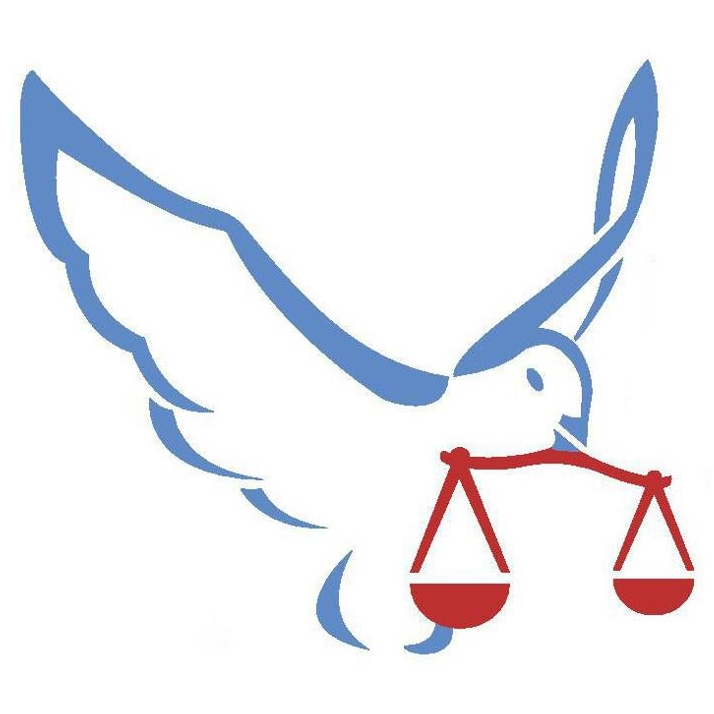

About : Newsroom : CARE's Work : Get Involved : Campaigns : Web Features : Contact Us : Careers
Death Toll in Haiti's Cholera Outbreak Surpasses 1,600
Please see the following pages for the most up-to-date news on our relief efforts:
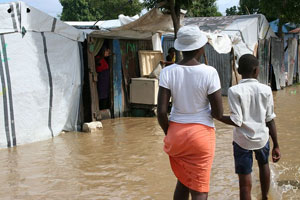 Residents walk through flooded areas in Léôgane after Hurricane Tomas. (2010 Marie-Eve Bertrand/CARE Canada) |
(UPDATED: December 14, 2010) Cholera has claimed the lives of 2,535 people and hospitalized 58,190 in Haiti. Since the first cases of cholera appeared at the end of October, more than 114,497 people have contracted the potentially fatal disease.
With more than 1 million people living in tents and under tarps following January's devastating earthquake, the outbreak is expected to grow worse before it gets better, affecting up to 400,000 people in the worst case scenario.
What is cholera and how is it spread?
The World Health Organization defines cholera as "an acute intestinal infection caused by the ingestion of food or water contaminated with the bacterium Vibrio cholerae. It has a short incubation period, from less than one day to five days, and produces an toxin that causes a copious, painless, watery diarrhea that can quickly lead to severe dehydration and death if treatment is not promptly given. Vomiting also occurs in most patients."
Cholera spreads quickly in water contaminated by feces. Heavy rains from Hurricane Tomas that lashed Haiti on November 5 and 6, sent water and mud contaminated with feces pouring into streets, buildings and homes.
''Health facilities are overwhelmed with cholera victims,'' says Dr. Franck Geneus, CARE's health manager in Haiti. ''The people are afraid and angry. They don't completely understand what is happening right now. People have to understand, cholera is something new to Haiti.''
CARE's response
CARE is stepping up our humanitarian response to the disease, focusing on our strengths and where we can make the biggest impact – that is, prevention and prepardness. We are disseminating cholera prevention tips to a growing audience in Haiti as the disease spreads across the country.
This work is carried out through radio broadcasts, "causeries," mothers' clubs, youth clubs, sensitization events and home visits. An estimated 40 percent of Haiti's adult population is illiterate; therefore radio announcements, public events and flyers with images play a great role in public outreach. The CARE team has also invented a song that tells about key hygiene behavior, such as washing hands with soap and how to safely prepare a meal. Children like humming the melody and thus memorize the precautions in a playful way.
Meanwhile, CARE continues its efforts in water and sanitation for Carrefour and Léogâne, two of the hardest-hit areas of the earthquake. Our work includes water trucking, hand-washing stations, construction and maintenance of latrines as well as hygiene workshops. To help keep public sources from contaminating, CARE also supports the chlorination of buckets of water at water points in Artibonite. Mortality rates in camps and the metropolitan area of Port-au-Prince are still significantly lower than in other, more remote parts of the country. This shows the lifesaving effects of dependable access to water, continuous hygiene promotion and the fact that medical facilities are relatively easy to reach.
Together with our partners in Haiti, CARE is carrying out additional health and hygiene activities, including providing safe drinking water, helping purify water, clorinating wells, training local volunteers on how to chlorinate well water, assisting with sanitation, installing hand washing stations and distributing oral rehydration solution, antibiotics, IV ringer lactate, cleaning products, soap, hygiene kits and aqua tabs. We're also helping with emergency case management, supporting clinics and distributing high-calorie food to pregnant and lactating women.
While CARE is in the midst of our lifesaving response to the cholera outbreak, we're looking toward the future. We'll soon prepare a 2-3 year response to the cholera outbreak that will address some of the underlying causes of the rapid spread of disease related to safe water, hygiene and sanitation.
Find out more about CARE's response to ongoing disasters in Haiti:
SOPHIE PEREZ: CARE IN HAITI COUNTRY DIRECTOR
Sophie discusses the earthquake and the dedication of the CARE staff in Haiti to working on relief projects, despite deep personal losses.
When you move the mouse over a tab the associated tab content is then displayed
CARE's Earthquake Response
CARE IS ON THE GROUND DELIVERING AID TO SURVIVORS
Devastation from the January 12 earthquake in Haiti was massive. But so was the outpouring of public support for relief and recovery efforts.Emy Merci, 39, was holding her newborn baby in the hospital soon after delivery, when she felt the earth start to shake on January 12. She received a hygiene kits (background) from CARE. (2010 Evelyn Hockstein/CARE)As a result, emergency aid has made a real difference in the lives of survivors, including the women and girls targeted in CARE's response. There has been no large outbreak of disease and no nutrition crisis. Virtually all displaced people have some form of shelter. And we are proud to be part of a response that has helped alleviate suffering for hundreds of thousands of people across Haiti.
Today, our relief efforts are currently focused in two areas of the country: Pétionville and Léogâne. We also have worked in Canapé Vert, Cité Soleil, Delmas, Gonaïves, Gros-Morne, Jérémie, Léogâne, Tabarre and Port-au-Prince. During the past six months, we have reached hundreds of thousands of people with aid.
CARE has distributed food, PUR® water purification packets, water, jerry cans, buckets, hygiene kits, shelter kits, emergency housing repair kits, solar flashlights, kitchen sets, mattresses, blankets, clean delivery kits, newborn kits, latrines, showers and worked on other projects that promote hygiene and sanitation. And we organized our distributions so that women and children, who are among the most vulnerable during times of disaster and crisis, have benefited from CARE's assistance.
WHAT IS IN THE WORKS
Using a community-based approach and working closely with the government, CARE is focusing on those most affected by the earthquake.
Shelter
As much as possible, we want to help families move from the camps back into their communities. CARE is doing so by distributing transitional shelter and home repair kits, providing economic opportunities and improving health and educational services – both in earthquake-affected communities and several outlying provinces. CARE also will continue to provide support to people remaining in camps.Daniel Léger, lives alone in his CARE-built shelter in Carrefour. He lost his leg eight years ago after an accident while working in construction. (2010 Natasha Fillion/CARE)Of immediate concern is a hurricane season predicted to be more active and more dangerous than usual. That's why we're importing emergency materials to repair damaged homes and to make 20,000 shelter reinforcement kits for families forced to live in self-built structures. CARE also continues to construct 25 to 30 transitional shelters per week, giving widows, women-headed households and other survivors a safe, secure place to rebuild their lives.
The shelters, roughly 13 feet by 15 feet with wooden frames and sheet metal roofs, are hazard-resistant – able to withstand earthquakes and high winds. They are designed to last at least 3 years – or 5 to 10 years with repair and maintenance. Not only that, but the materials are reusable, and the design can be adapted by beneficiaries to form the core of a permanent dwelling to suit the families' tastes and local housing styles.
Our shelter teams, local authorities and community associations are working together to identify beneficiaries using the following criteria: families with available plots whose homes that have been destroyed or rendered unrepairable. CARE is targeting people who are most vulnerable, including female-headed households, families with children under age 5, persons suffering of chronic illness, disabled people and the elderly. Each person receiving a shelter is assigned two CARE carpenters. Along with three friends or family members, the team can build the shelter in two days.
Since starting in June, 33 percent of transitional shelters targeted for 2010 have been constructed.
Women and Girls
CARE's programs prior to the earthquake were designed to meet the needs of women and girls, making sure they had significant opportunities to improve their quality of life. Now, we are integrating these approaches into all areas of our emergency response. For example, nearly half the participants in cash-for-work activities are women; half the children receiving recreation kits will be girls; and many of our projects seek to lessen workload burdens of women, such as collecting water."Femme Vigilante" women' committee members, Uphania Ladouceur, 30 (left) and Mesidor Hyguette, 29, (right) at a meeting with CARE in Léogâne on June 30, 2010. (Natasha Fillion/CARE)We are also working to help prevent violence against women in Haiti's crowded camps. We've conducted community-training activities at 14 different sites in Carrefour and Léogâne, covering topics, such as gender-based violence, sexually-transmitted diseases, HIV and AIDS and family planning.
In partnership with local health committees, CARE is opening more than 20 women's centers that will serve more than 40,000 women and girls. The centers that will serve as places that women can go to for counseling and referrals, especially in the case of reproductive health issues and matters of gender-based violence. In addition, the centers will offer activities to support pregnant women, the importance of prenatal consultations, nursing, neonatal care and family planning, the danger signs of pregnancy and use of the clean delivery kits and newborn kits.
Water, Sanitation Hygiene
CARE is providing water, building latrines and showers, and organizing citizens to promote good hygiene. Since the earthquake, we have built 800 latrines and 140 showers at 60 sites between Léogâne and Carrefour. We've also installed 23 water bladders in 21 locations, bringing clean drinking water to a total of 45,000 people.A mother washes her baby girl in a bowl in Place St. Pierre Camp, Pétionville. Delivering clean water for consumption and hygiene has been a vital component of CARE's relief efforts. (2010 CARE/Sabine Wilke)In the immediate days after the quake, sanitation quickly became a grave concern, especially the removal of human waste from sites where it was impossible to install emergency trench latrines. CARE purchased 10 mobile vacuum trucks to help meet this need.
In addition, CARE is conducting hygiene promotion activities through local committees in 133 sites in Carrefour and Léogâne. These activities include house visits, group training sessions and peer outreach, such as child-to-child and mother-to-mother. So far, 43 latrine-cleaning committees and 76 site-cleaning committees have been created. We've also distributed more than 32,000 hygiene kits. Moving forward, we plan to work with schools to introduce good hygiene habits to students, replicating programs we have done in other countries.
With the installation of waste bins, the problem of household waste disposal around the camps has been halted. Today, Haiti's camps are litter-free and people are enjoying the cleanliness of the water and sanitation facilities. This is helped by CARE's cash-for-work project that helps people earn a living while keeping the settlements clean of debris.
Livelihoods and Food Security
CARE has supported affected families in non-urban areas (including families who are hosting displaced people) to ensure that sufficient food is locally produced, in order to avoid widespread hunger and reduce the need for people to travel to quake-affected urban areas in search of food.Mona Jean Pierre and Berta Noel are participating in CARE's "cash for work" program planting peppers, eggplant, tomatoes and other vegetables to eat and sell in the local markets. (2010 Natasha Fillion/CARE)Our approach includes paying people for infrastructure projects, so they have money to buy food. Through cash-for-work programs, CARE has assisted 3,154 affected families, which is 81 percent of the project's target. Of the people employed, nearly half of them are women. Through these programs, 33 kilometers of irrigation canals have been cleared; 7 kilometers of feeder roads have been rehabilitated, facilitating exchanges between communities; dry stone walls supporting 250 meters of ravines have been built; and rubble from a church and an orphanage have been removed. Communities identified all of these projects as high priority.
CARE also is promoting gardening to improve families' access to fresh food. So far, 146 pounds of spinach and okra seeds have been distributed to 1,575 families, as these vegetables are easy to grow from seeds. Additionally, tomatoes, chilies and eggplants are being started at local nurseries to improve chances for survival; and the seedlings are being distributed to families.
Children's Education, Psychological Care and Well-Being
Our education efforts includes a project to help 20 directly-affected schools in Léogâne and 50 indirectly-affected schools (serving displaced children) in the areas of Gonaïves, Gros-Morne, and Jérémie. The project will also support students to resume learning activities. Schools will be assisted with refurbishing, e.g. desks and chairs for students and teachers; and their students will be provided school and hygiene kits.
In order to contribute to the stability and security of children, we're training teachers and parents on psycho-social support for children ages 6 to12. And these adults help spread the messages to other teachers and families in the neighborhood. As of the end of October, we'd reached 46 percent of our target.
Out trainings cover topics such as child development, conflict management and post-traumatic stress symptoms, such as loss of appetite, grinding the teeth, apathy, aggressiveness, nightmares, difficulty concentrating, hyperactivity, intense sadness and difficulty sleeping. Participants employ activities for children such as drawing and coloring (which provide them a way to express their emotions), and sports and games, such as hopscotch and marbles.
We've identified 100 schools where CARE will provide psycho-social training for teachers and caregivers. The schools are located in the towns of Gonaïves, Gros-Morne, Léogâne and Jérémie, where many displaced children are now living. In addition to addressing the emotional well-being of the children, we'll provide school furniture and supplies, and rehabilitate school water and sanitation facilities, and promote recreational activities so that the children have a supportive, comfortable and fun place to resume their studies.
Finally, CARE intends to distribute 8,000 recreational backpacks to families whose children are not currently attending school. The backpacks will contain jump ropes, marbles, pens, colored pencils and pencil sharpeners, among other items.
CARE'S LONG-TERM RELIEF AND RECOVERY PLANS
We have developed a 5-year, $100 million strategy for relief and rehabilitation in Haiti, one guided by the priorities of the Haitian people and the Haitian government. It places special emphasis on women and girls who, with the right support and resources, can help build a better Haiti. The strategy focuses not only on earthquake-ravaged areas but also the provinces, so that economic opportunities and social services are spread throughout the country.
Background
EARTHQUAKE IN HAITI
Click the map above to download a Google Earth file and see what CARE is doing in Haiti now (updated March 31, 2010)!
Around 5:00 p.m. on Tuesday, January 12, 2010, a powerful 7.0-magnitude earthquake struck 10 miles southwest of Haiti's capital city, Port-au-Prince, and triggered a tsunami warning for the region. A series of aftershocks – more than 30 – measuring 5.0 or greater on the Richter Scale, followed throughout the night and into the morning. The nearby towns of Carrefour and Jacmel and other ares to the west and south of Port-au-Prince also were affected, with the town of Léogâne reported to be 80 percent destroyed.
Buildings across the area area collapsed, leaving hundred of thosands homeless, injured and dead. The exact number of people killed will probably never be known, but the Haitian government places the figure at 222,517, and some 300,600 wounded. Three million people were directly affected, of whom the government estimates 1.2 million lost their homes.
Several hundred spontaneous sites in and around Port-au-Prince were established to house affected families, who continue to rely on the assistance of the international community and direct intervention of approximately 1,000 humanitarian organizations, including CARE. There was also a mass migration of an estimated 600,000 persons away from affected cities. Host families and communities in outlying areas are bearing much of the burden of supporting these dispaced people.
CARE IN HAITI
CARE began working in Haiti in 1954 to provide relief assistance after Hurricane Hazel. Our work shifted to development programming in 1959, with a focus on maternal and child nutrition. In 1966, CARE launched community development activities in the country's impoverished Northwest region. In the 1970s, we broadened our focus to include health care for preschool children, safe drinking water and income-generating activities. By the 1980s CARE's programming in Haiti included agriculture and natural resources, preschool education, water and sanitation, primary health care and small enterprise projects. Following the coup d'état in 1991, CARE concentrated on humanitarian feeding and rehabilitation projects.
Today, CARE's work in Haiti reflects an integrated approach, with projects in HIV and AIDS, reproductive health, maternal and child health, education, food security, and water and sanitation. CARE works closely with local nongovernment organizations (NGOs), private companies, community organizations and the Haitian government to build local capacity and achieve sustainable development.
Our emergency response efforts in Haiti also have continued. More recently, tropical storm Jeanne nearly destroyed the regional capital city of Arbonite in 2004. Following that emergency, CARE Haiti developed a comprehensive emergency preparedness plan focused on response to "recurrent emergencies in the country: flooding and drought. This plan was used in 2008 when four storms, including hurricanes, crossed the country in August and September of that year.
CARE's work in emergencies and times of crisis goes back to our founding in the aftermath of World War II to deliver food and supplies to war-torn Europe by means of the famous "CARE Packages®." In the decades since, we have responded to hundreds of humanitarian disasters worldwide – from earthquakes, to floods, to the consequences of armed conflict. Today, CARE reaches some 11.7 million people each year with immediate relief and long-term assistance coping with, preparing for and preventing disasters.
Find out more about our work in Haiti.
DELTA AIR LINES PARTNERSHIP
Delta Air Lines, a long time CARE partner, is providing transportation support for Atlanta-based CARE staff into Haiti to support our Haiti Country Office team on the ground with emergency relief. Click here to donate your Delta SkyMiles to CARE through Delta's SkyWish program.
Videos
HAITI: SIX MONTHS LATER
An overview of CARE's work in Haiti since the January 12, 2010 earthquake.
SALLY AUSTIN: HEAD OF EMERGENCY OPERATIONS IN HAITI
Sally discusses the transitional needs of the Haitian people six months after the earthquake.
JIM KENNEDY: SHELTER COORDINATOR IN HAITI
Jim talks about CARE's initial efforts to assist Haitians with emergency shelter and our efforts to help Haitians with transitional housing today.
________________________________________
About Us
CARE is a leading humanitarian organization fighting global poverty. We place special focus on working alongside poor women because, equipped with the proper resources, women have the power to help whole families and entire communities escape poverty. Women are at the heart of CARE's community-based efforts to improve basic education, prevent the spread of disease, increase access to clean water and sanitation, expand economic opportunity and protect natural resources. CARE also delivers emergency aid to survivors of war and natural disasters, and helps people rebuild their lives.
Click here for answers to some of our most frequently asked questions (FAQs).
|
Our Vision
We seek a world of hope, tolerance and social justice, where poverty has been overcome and people live in dignity and security. CARE International will be a global force and a partner of choice within a worldwide movement dedicated to ending poverty. We will be known everywhere for our unshakable commitment to the dignity of people. |
|
Our Mission
Our mission is to serve individuals and families in the poorest communities in the world. Drawing strength from our global diversity, resources and experience, we promote innovative solutions and are advocates for global responsibility. We facilitate lasting change by:
Guided by the aspirations of local communities, we pursue our mission with both excellence and compassion because the people whom we serve deserve nothing less. |
|
Our Board of Directors
CARE's board of directors is the organization's governing body, elected by the members at an annual meeting. All members are responsible for gaining a basic understanding and initiating action in support of CARE's mission, goals and programs. This includes assisting in expanding CARE's outreach and increasing its visibility and donor support. All board members are volunteers and serve without compensation. |
|
Our Executive Team
The board of directors appoints CARE's president, treasurer and secretary. The president appoints the rest of CARE's executive team, including the chief operating officer, general counsel and senior vice presidents of finance, IT and administration, human resources, program, and external relations. |
Our History
CARE is one of the world's largest private international humanitarian organizations, committed to helping families in poor communities improve their lives and achieve lasting victories over poverty. Founded in 1945 to provide relief to survivors of World War II, CARE quickly became a trusted vehicle for the compassion and generosity of millions. Click here to read more about the history of CARE.
| info@pap.care.org | |
| Address | 92 Rue Gregoire (P.O. Box 15546), Peton-Ville, Port-au-Prince |
| Phone | 1 800 422-7385,, |
| Fax |




